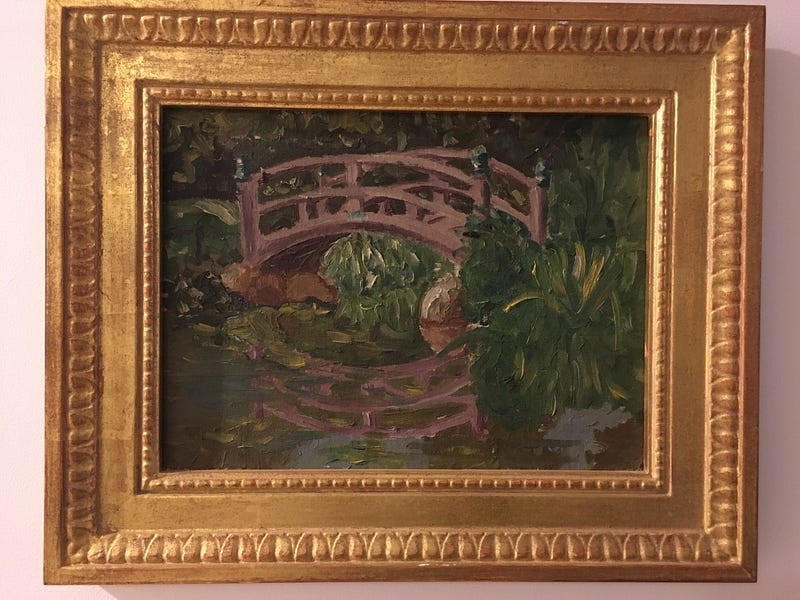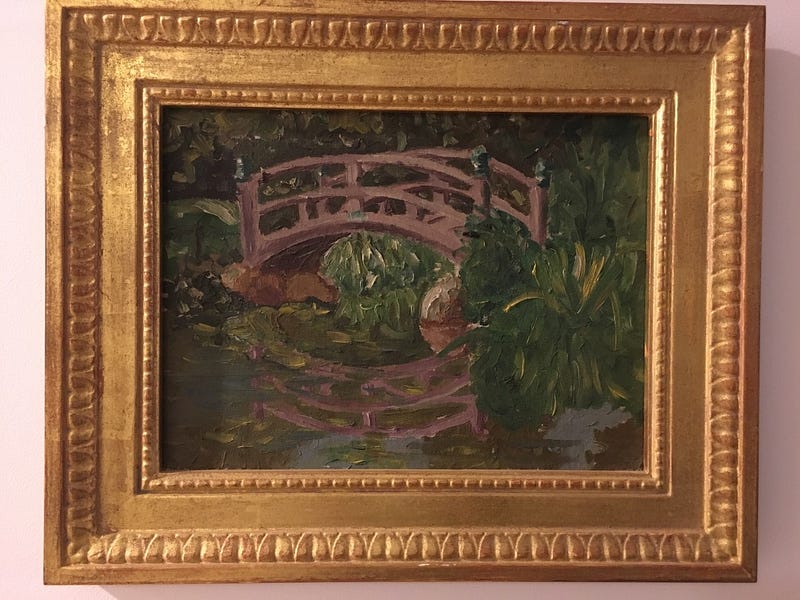
The earliest example of my father’s art to survive is a painting of a Japanese bridge that he used to hang in his Victorian home in upstate New York. It hung for years in my kitchen. On the back, it’s signed and dated “1940?” in my father’s familiar handwriting, clearly written much later on; in 1940 he was thirteen years old. Though my father (Earle) and grandfather (Andrew) didn’t get along, my grandfather kept it carefully through moves around Chicago and then to Florida. When Andrew asked Earle to list what he wanted to inherit from his house my father included that painting and a ceramic sculpture he made of a horse’s head, also made as a student.
To represent light, water, rock, foliage, and wooden bridge as a coherent whole on a small canvas took skill. Perhaps Earle worked from a photograph. I never asked. My father later earned his living selling picture frames so he must have had a say in the ornate gold-painted frame that is as memorable as the painting itself. In his attic after his death my sisters and I also found some awkward paintings of flowers in vases from 1942 that he did not frame or display in his home. The Japanese bridge painting, on the other hand, was symbolic of something, for him and for me: my father’s precocious talent? his early identity as an artist?

“I painted this before I had ever seen the Monet,” he would say of the painting when I was growing up. (The Art Institute of Chicago did indeed own and exhibit a very similar painting by Monet after 1933. Is it possible that my father hadn’t seen it there?) My father would then pause and sometimes add, “those gardens aren’t there anymore. They were taken down during World War II.” He tells this story again in the video my husband made of my father, walking around his house, commenting on his art, the year before he died. It was clear Earle was very proud of that painting; it’s clear in the video that he loved giving us that art tour of his house.
That particular bridge, called a moon bridge because of its high round shape, was originally part of the Japanese pavilion for the 1893 Chicago Exposition in Jackson Park, on the South Side near where my father would later grow up. It was given to the city after the fair was over and it did indeed fall into disrepair after its Japanese caretaker, photographer Shoji Osato, was arrested and confined to his home the day after the attack on Pearl Harbor. The garden was vandalized throughout the war, then burned down in 1946. The buildings and bridge have since been restored and now it is possible to go and reconstruct the view my father painted, though I haven’t done so. As physical evidence, the originals are gone. The painting “preserves” it.
Now, the destruction of that bridge seems intertwined with the loss of childhood itself. My father was drafted for World War II just after he turned eighteen. He lost his older brother to that war. Perhaps the painting served as a thread of connection, a bridge, to that past, to his father and brother, to Chicago after he left it for New York. Now it arches forward to connect me to them too.
In my memoir this story is embedded in a chapter about the 1940s that focuses on my father and his brother. Because that brother died in 1944, at the age of 21, no one I knew had ever even met him. I would ask my father what Andrew Jr. was like, and Earle used to say that his brother wanted to be an engineer, that he wasn’t interested in art. But in working on this memoir I found a whole album of photographs that Andrew Jr. had taken while he was in high school and college. Some of them were clearly studies — of telephone wires, household objects, flowers. Many were of my father himself, a carefree-looking child. At least one was labeled “artistic.”
This painting and its story—of losses from the war— seem integral to my family’s larger narrative of art and identity, of preservation and grieving. It shows common tropes, like my father’s awareness of the artistic canon (the Monet reference) and maybe his investment in being “the artist” of the family, even though his father’s commercial career made him one too.
Have I squeezed all the juice out of this painting and everything I knew and found out about it? These Substack posts have been useful for revisiting evidence as well as critiquing the writing choices I made. Here, I think the original passage did a good job of connecting my father’s art-making as a child to his brother’s, but maybe I didn’t make a strong enough connection between the war-time contexts— that this bridge, like Andrew Jr., disappeared during the war, and displaying this painting, like telling the Cracker Jack story over and over, was a way for my father to hold on to something he had lost.
One of my first freelancing jobs was writing audiotours for museum exhibits. I had about 60 seconds of text per “stop”—which was a great exercise in concision—and one hard and fast rule: always come back to the art. Even if you describe the artist’s life or the time period or the work’s influences, always bring the viewer back to look at the art itself. Leaning in to this idea, I circle back to the arching bridge, struck now by the thick patches of paint, especially under the bridge. It makes me wonder if Earle had indeed seen the Monets or other impressionist works at the Art Institute of Chicago, and was trying on an early role.
I will eventually turn on paid subscriptions but for now, try this out!
Exercise: How do you know if you’ve gotten as much as you can from your evidence? Take a look at a text or image or interview and see if there’s anything you never considered. If in doubt, return to its objectness: read it out loud, turn it over and look at the other side, hold it in your hands…. Put it down and pick it up again.





Hi Victoria - I missed this because it didn't go to my Substack inbox for some reason. What a treat to see the video of your father taking you on a tour of his house! You can really see the pride and happiness on his face as he walks you through his artwork. What a gift that you have that video.
Very nicely told, with the included connective tissue of the war with Japan, his brother's death, and the painting, and the question of whether or not he had ever seen the Monet left subtly hanging. I loved the video! So tender and tenderly rendered by the son-in-law, as well as Victoria in the background.